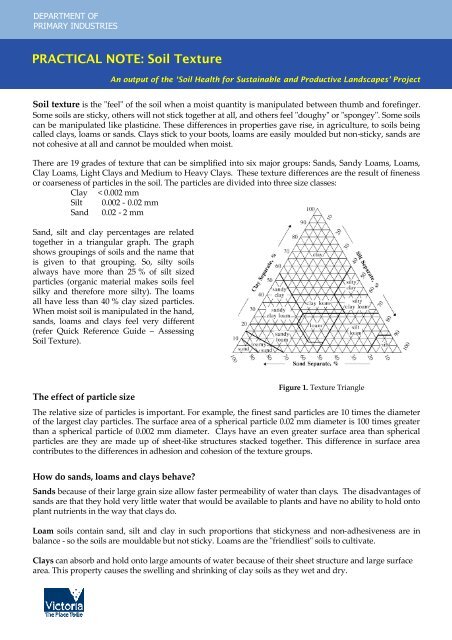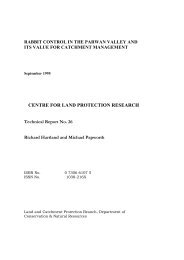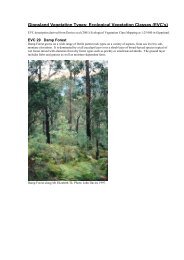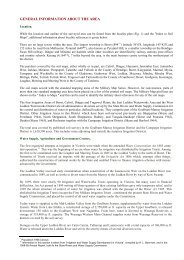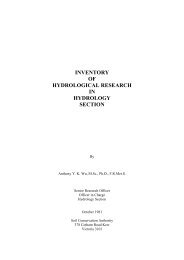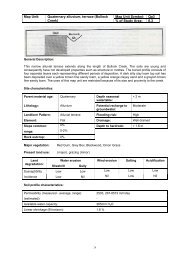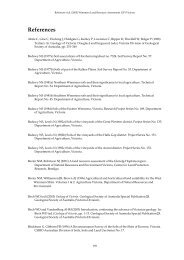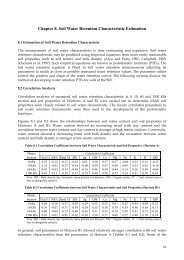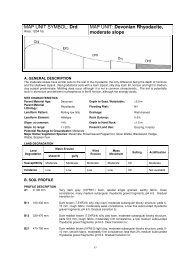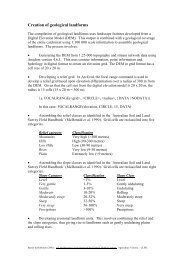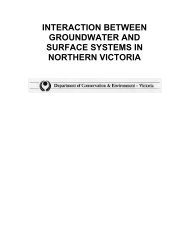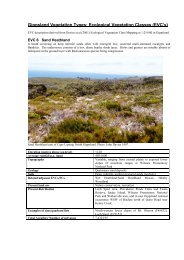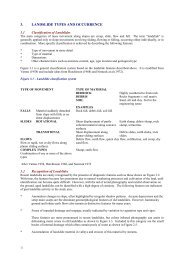PRACTICAL NOTE: Soil Texture - Department of Primary Industries
PRACTICAL NOTE: Soil Texture - Department of Primary Industries
PRACTICAL NOTE: Soil Texture - Department of Primary Industries
Create successful ePaper yourself
Turn your PDF publications into a flip-book with our unique Google optimized e-Paper software.
DEPARTMENT OFPRIMARY INDUSTRIES<strong>PRACTICAL</strong> <strong>NOTE</strong>: <strong>Soil</strong> <strong>Texture</strong>An output <strong>of</strong> the ‘<strong>Soil</strong> Health for Sustainable and Productive Landscapes’ Project<strong>Soil</strong> texture is the "feel" <strong>of</strong> the soil when a moist quantity is manipulated between thumb and forefinger.Some soils are sticky, others will not stick together at all, and others feel "doughy" or "spongey". Some soilscan be manipulated like plasticine. These differences in properties gave rise, in agriculture, to soils beingcalled clays, loams or sands. Clays stick to your boots, loams are easily moulded but non-sticky, sands arenot cohesive at all and cannot be moulded when moist.There are 19 grades <strong>of</strong> texture that can be simplified into six major groups: Sands, Sandy Loams, Loams,Clay Loams, Light Clays and Medium to Heavy Clays. These texture differences are the result <strong>of</strong> finenessor coarseness <strong>of</strong> particles in the soil. The particles are divided into three size classes:Clay < 0.002 mmSilt 0.002 - 0.02 mmSand 0.02 - 2 mmSand, silt and clay percentages are relatedtogether in a triangular graph. The graphshows groupings <strong>of</strong> soils and the name thatis given to that grouping. So, silty soilsalways have more than 25 % <strong>of</strong> silt sizedparticles (organic material makes soils feelsilky and therefore more silty). The loamsall have less than 40 % clay sized particles.When moist soil is manipulated in the hand,sands, loams and clays feel very different(refer Quick Reference Guide – Assessing<strong>Soil</strong> <strong>Texture</strong>).The effect <strong>of</strong> particle sizeFigure 1. <strong>Texture</strong> TriangleThe relative size <strong>of</strong> particles is important. For example, the finest sand particles are 10 times the diameter<strong>of</strong> the largest clay particles. The surface area <strong>of</strong> a spherical particle 0.02 mm diameter is 100 times greaterthan a spherical particle <strong>of</strong> 0.002 mm diameter. Clays have an even greater surface area than sphericalparticles are they are made up <strong>of</strong> sheet-like structures stacked together. This difference in surface areacontributes to the differences in adhesion and cohesion <strong>of</strong> the texture groups.How do sands, loams and clays behave?Sands because <strong>of</strong> their large grain size allow faster permeability <strong>of</strong> water than clays. The disadvantages <strong>of</strong>sands are that they hold very little water that would be available to plants and have no ability to hold ontoplant nutrients in the way that clays do.Loam soils contain sand, silt and clay in such proportions that stickyness and non-adhesiveness are inbalance - so the soils are mouldable but not sticky. Loams are the "friendliest" soils to cultivate.Clays can absorb and hold onto large amounts <strong>of</strong> water because <strong>of</strong> their sheet structure and large surfacearea. This property causes the swelling and shrinking <strong>of</strong> clay soils as they wet and dry.
DEPARTMENT OFPRIMARY INDUSTRIESClays are therefore also important in generating cracks in soil through which roots can easily pass. Ofcourse, when clays are wet and swollen soil drainage is affected and water cannot pass freely. Thesurfaces and edges <strong>of</strong> the sheet structure <strong>of</strong> clay particles carry negative and positive charges. Elementssuch as Potassium, Calcium and Magnesium are held on these charged surfaces and can be taken up insolution by plant roots. Clays therefore play an important role in soil fertility.What else effects soil texture?How moist soil feels when manipulated in the hand is influenced by how much sand, silt or clay is in thesample, and also soil components such as organic matter.Table 1. Influences on soil textureMedium and coarse Easily feltsandFine sandFelt and heard by manipulating the soil close to the earSiltSilky or smooth feeling similar to that <strong>of</strong> talcum powderClaySticky, cohesive and plasticClay type Clay mineralogy affects tractability. Montmorillonite is very fine andencourages ribboning. Kaolinite is very coarse and will inhibit ribboningOrganic matter Cohesion <strong>of</strong> sandy textures and greasiness <strong>of</strong> claysOxidesCementation (Al & Fe) masks fine texturesCarbonatesCohesion in sands and loams, but inhibits ribboning in claysOrganic matter is an important contributor to soil texture and helps to ameliorate stickiness and also helpssandy soils hang together, making them feel more loamy.How does texture change?The texture <strong>of</strong> soil is considered to be a stable property. That is, changing the texture <strong>of</strong> your soil ispossible but involves considerable mechanical and financial input. One example is clay delving, whereclay from the subsoil is mixed with the sandy surface soil. Clay delving is used in the Mallee and much <strong>of</strong>Western Australia. For most land managers, changing the texture <strong>of</strong> the soil is not a viable option for soilmanagement.<strong>Texture</strong> <strong>of</strong>ten changes with depth down the soil pr<strong>of</strong>ile. It is important to describe texture changes thatoccur within the soil pr<strong>of</strong>ile. Many <strong>of</strong> our soils have loamy surface soils and heavy clay subsoils. Thisarrangement controls the movement <strong>of</strong> water through the pr<strong>of</strong>ile, the clay restricts downward drainageand encourages water movement along the top <strong>of</strong> the restricting layer. This can result in waterlogging <strong>of</strong>the surface soil, even though the subsoil may not be saturated.Further informationFor further information on the soils <strong>of</strong> your region visit Victorian Resources Online:www.dpi.vic.gov.au/vroOr contact your local Healthy <strong>Soil</strong>s Officer at the <strong>Department</strong> <strong>of</strong> <strong>Primary</strong> <strong>Industries</strong>:MalleeSouth WestMelissa CannTim Johnston: 03 5036 4815 : 03 5226 4723: Melissa.Cann@dpi.vic.gov.au : Tim.Johnston@dpi.vic.gov.auWimmeraBernard Noonan: 03 5362 0734: Bernard.Noonan@dpi.vic.gov.auThis publication may be <strong>of</strong> assistance to you but the State <strong>of</strong> Victoria and itsemployees do not guarantee that the publication is without flaw <strong>of</strong> any kind or iswholly appropriate for your particular purposes and therefore disclaims all liabilityfor any error, loss or other consequence which may arise from you relying on anyinformation in this publication.


